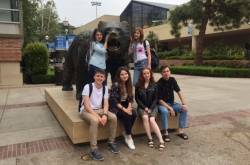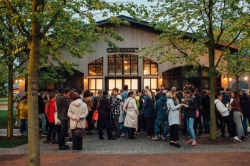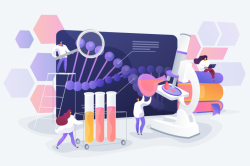What is citizen science and why is it so popular now?
According to the Oxford Dictionary, citizen science is “The collection and analysis of data relating to the natural world by members of the general public, typically as part of a collaborative project with professional scientists.” The definition appeared in 2014, the phenomenon itself, however, has been known since the XIX century. Obviously, there was no Internet two hundred years ago and the opportunities were limited compared to what we can do today. Nevertheless, there were many skilled naturalists who collected plants and insects back then. Although they were not professional scientists, but their knowledge was enough to communicate with them, be published in newspapers and magazines and contribute to various research activities.
Citizen science is not new, but it has received a new impulse for development in recent years. One of the reasons for that is an attempt of the scientific community to solve the problem of making science more democratic and open to the public. It became necessary that not only scientists, science journalists or communicators talk about science, not only experts present new discoveries, but the public itself was involved in research.
According to Julia Lorke, now we have many definitions of citizen science. Each institute and organization has its own vision of the concept.

“For the London Museum of National History with its experts actively interacting with amateur researchers, citizen science means volunteers participating in scientific projects and expanding our knowledge of the natural world through systematic observation, analysis or interpreting our observations of the environment. Obviously, the Museum is particularly interested in that field”, she says.
Becoming a civil scientist
A number of researchers, for example, Muki Haklay, a professor at University College London (UCL), identified several opportunities for participation in civilian science projects.
The simplest way is the first level or crowdsourcing. The participants at this stage are simply a data source, they are not involved in problem solving or data analysis. An example of such participation may be various platforms that allow users to share their observations. For instance, the Dark Sky Meter service allows you to take a photo of the night sky, measure light pollution and update the map with your data using an iOS application.
It is also common practice, for example, in Australia and other countries to collect photos from eyewitnesses and researchers who recorded a case of animal death on the road during a car accident. Users can send these snapshots and geographic coordinates via special services. Then using these data scientists can create maps with the most dangerous areas for the animals and create a way of solving the problem.

Another project that is developing in London and connected with maps is “Mapping for Change”. Both individuals and organizations that want to understand, improve and use information about the places most important for them can use the service. It actually offers a wide range of services and is based on an online cartographic platform. Users’ photos and notes on how to improve a certain place from environmental or infrastructural point of view serve as the basis for the platform. The service aims to create a tool for communication with the public and other interested parties in various projects. The authors emphasize that the service is very user-friendly so that anyone can upload their photos.
The second level: “distributed intelligence”
This is a more complex level that directly involves the participant. At this stage, an amateur scientist can already analyze some types of collected data. An example of such involvement is the Galaxy zoo project for classification of various galaxy types. It offers to classify more than 60 million images of galaxies from the Sloan Digital Sky Survey project. Users are given the task of classifying images of remote astronomical objects. They do not need astronomical education for that, as the rules of classification are set out in the user manual on the website.
In February 2009, an improved version of the project (“Galaxy Zoo 2”) came to life, providing a detailed classification of 250 thousand of the brightest objects that were studied in the first project. We have to note that the project provided significant results. A new type of galaxy (Pea galaxies “Green Peas”) was created in 2009 based on the characteristic features of objects that were identified by many participants.
The project’s popularity attracted other scientists and in 2009 the project Zooniverse was created with more opportunities for amateur researchers.

The new project allows amateurs to participate in research in the field of astronomy and climatology. By April 2011, the project attracted almost half a million participants. Currently, the project consists of many subprojects apart from the Galaxy Zoo. The Galaxy Zoo Hubble classifies hundreds of thousands of galaxies with the help of Hubble Telescope Images. The Moon zoo studies the Moon based on the moon probe data. The Old Weather is designed to study the weather in the past, using data from the WWI logbooks. The Solar Stormwatch was created to observe solar flares.
Another open project for amateur researchers in the field of biology is iNaturalist. It is a scientific online network of naturalists, civil scientists and biologists, based on the concept of mapping and sharing biodiversity observations around the world. Observations conducted by volunteers provide valuable open data for various scientific research projects, museums, botanic gardens, parks and other organizations. Since the service was created in 2008, iNaturalist users have contributed more than eight million observations. You can add information both on the website or using their mobile application. In 2014, the organization merged with the California Academy of Sciences.
The third level: “science through participation”
At this level, civil scientists are involved in the research process by, for example, taking part in solving the scientific problems. An example of such cooperation is the project Flint water study updates, designed to solve drinking water quality problems in Flint, Michigan, USA. A few years ago, 100,000 residents of the city noticed an unusual colour and an unpleasant smell of water coming from the tap. In 2016, the blood of some Flint citizens, including children, was found to have an abnormal lead content. After that, a state of emergency was introduced in the city.

A team from Virginia Tech University is involved in trying to solve the global problem. The project participants see their objectives as providing support to civilian scientists who are interested in improving the quality of drinking water, as well as providing residents of Flint with independent information about their tap water, conducting research and monitoring water quality, collecting data and generalizing it in order to overcome the crisis.
Fourth level: “extreme”
This level implies that the public rather than scientific organizations and institutions can raise scientific questions and problems. Then the public is involved in the solution of such issues by collecting and analysing data. The first initiative in the world that aims to involve all kinds of communities is Participatory Science Platform (PSP) based in New Zealand.
The PSP creators note that any resident of the country has the right to get the opportunities and means for scientific research. The project is an environment that helps its participants use common data and participate in discussions. The PSP is based on the method of conducting joint research, during which volunteers can be involved in the process of developing and promoting projects related to local scientific research, working together with scientific and technological specialists.
The platform funds such projects that are a collaboration with scientific, educational or technological value, that meet public demands, attract students and community representatives to interact with companies and scientific institutions and offer the participants to conduct locally relevant research using local knowledge and citizens’ contributions to get high-quality scientific or technological results.

Julia Lorke points out that this level offers maximum degree of amateur involvement in research projects and interaction that allows co-creation.
Amateur research helping science
Undoubtedly, professionals with experience have to conduct any kind of research projects. Imagine this though: if your project implies collecting a large number of very specific plants and your travel budget is limited using local residents’ data and samples can be a good way to carry out your research. Data collection is one of the most important opportunities that civilian science offers professional scientists, says Julia Lorke. That is why scientists do not only communicate with other scientists but also interact with a wide range of amateurs.
Such interaction can help not only natural scientists. History museums, for instance, can fix and preserve cultural heritage by collaborating with volunteers.
Of course, professional scientists are interested in high quality information. Data collected by non-specialists is of lower quality, but in general, as several studies show, it can still help in obtaining relevant information. For example, one of the works that analyzed data on plants obtained by amateurs and professional scientists proved that the former are able to do this at a sufficiently high level (the effectiveness of data from scientists was 88%, whereas the amateurs “scored” 72%), says Julia Lorke.
Explaining scientific work and finding like-minded people
In the UK, the idea of a public understanding of science has been developing for years. This means that scientific knowledge and research results should be conveyed to the general public, to people who have minimal understanding of science. Scientific communicators are engaged in communication between scientists and representatives of the public. In the context of developing citizen science, they also focus on dialogue between specialists with specific knowledge and the public, who cannot receive information from the primary source, which is articles in specialized scientific journals.
The development of citizen science sets several main tasks for scientific communication. First, ensuring the provision of a wide range of consumers with scientific information; second, establishing a system of volunteer involvement in research and, finally, communicating the concept of “responsible research and innovation” to the public.
The latter means that by discovering or creating something new, scientists have to first consider the circumstances in which the development will be used. On this basis, they also need to be sure that the end users of the development will be able to use it appropriately. This simple idea implies creating a full-scale interaction system for scientists, developers and the society that is supported by science communicators.
The data and metadata of citizen science projects should be made available to the public and, whenever possible, all research results are published in the format of open access. That explains the popularity of “Open Science” concept in Europe. It implies that not only scientists but also any interested user can apply scientific knowledge and research results, emphasizes Julia. All this enables the science communicators to explain the principles of scientific research to the public and ensure a correct understanding of their results.
For the users themselves, participation in citizen science projects is first and foremost an opportunity to obtain additional specialized knowledge, to immerse in the process of conducting scientific research, and also to try out new areas of knowledge, not only scientific but also, for example, in the field of science communication. Another aspect is meeting like-minded people. For example, if you have been studying birds for a long time and observing their behaviour, you can join a birdwatchers community to find friends and improve your knowledge in this area.

Useful resources
“The Ten Principles of Citizen science” are set out in a special document prepared by a working group from the European Citizen Science Association. The principles, which are a set of best practices and recommendations for citizen science projects, were presented at the ECSA General Assembly in Barcelona in 2015.
Currently ECSA brings together more than 200 individual members and organizations from more than 28 countries throughout the European Union and beyond. Here the groups who have built or just want to build the principles of citizen science can interact through H2020 projects and contribute to political reviews, an open platform for scientific policy and be a part of developing the best practices in citizen science.
Another useful resource for those who are only acquainted with the principles of citizen science is a platform that provides information on more than 1000 research projects in the field of citizen science. The tools developed by SciStarter with support of the National Science Foundation allow civil scientists to find, join and track their own contributions to projects and platforms. The main goal of the organization is to overcome obstacles for amateur researchers. Last year this organization held the first “Citizen science Day” with support from Citizen Science Association discussing the possibilities of developing civilian science tools with a number of departments of the United States.
Translated by Pavel Vorobyev




